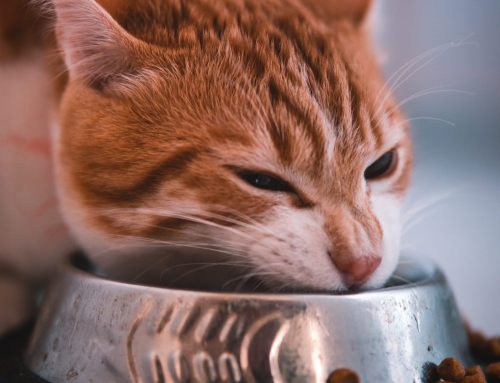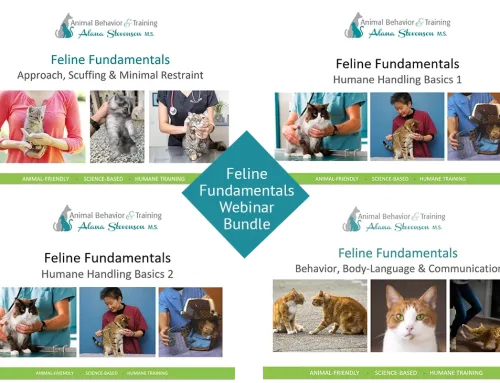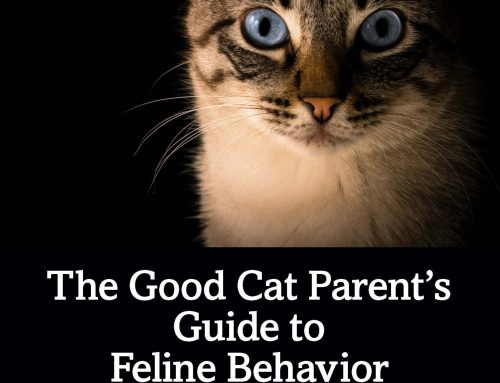
Over the last 10-15 years, there has been a growing trend and obsession to have skinny cats, ironically at a time when the human population has gotten fatter.
The eating habits and metabolisms of domestic cats are very different than those of humans and dogs. Cats naturally eat 10-20 small meals a day. They really are nibblers.
Traditionally, cats have been free-fed. This means a bowl of food was left out for them to nibble on, whenever they wanted. They also were let outdoors to hunt. When they came home, they’d be supplemented with real food (“people food”).
Adult cats don’t exercise much. They sleep a good portion of the day and when they hunt, they sit, wait and ambush. Cats conserve energy. They are not meant to exercise for long stretches of time.
In addition, cats don’t handle stress well. Psychological stress can make cats physically ill. This is known and has been scientifically studied in cats. There is evidence that stressed cats have shorter lives than happy and relaxed cats. However, there is no scientific evidence that verifies that fat cats have shorter life spans than thin cats.
It’s true cats may eat when they are bored or stressed, just like people. Due to it being unsafe for cats to roam and hunt outdoors, we tend to keep cats inside, which is a responsible thing to do. On the flip side, many indoor cats are bored and need to be entertained. Putting indoor cats on regimented diets or restricting meals often increases anxiety and worsens existing behavioral problems.

When cats are constantly hungry and fed tiny, restricted meals, they are more likely to exhibit petting aggression, play aggression, and inter-cat aggression and conflict.
An inability to calm down, keeping clients up all night, constant vocalization, jumping on counters and raiding cabinets, being obsessed with food, and gorging—eating quickly and then throwing up, are all symptoms of food restriction and signs of a hungry cat.
Free-feeding can resolve many feline behavioral problems I see.
There is a difference between being plump, pudgy, and round, and being obese. Obesity to the point where cats have difficulty self-grooming, jumping on and off furniture, and moving comfortably is obviously a serious health issue. When cats are older, especially over the age of 12, nearly all of them have arthritis. Carrying too much weight can and will put excess strain and pain on their joints.
However, the amount of stress caused by sudden diets and food restriction can negate any physical benefits. If you have a pudgy older cat, it’s likely better to add large soft intermediate surfaces for your cat to climb up and down, supply heating pads and add water bowls, and provide a stress-free environment rather than put your cat on a sudden diet and keep your cat hungry.
If your cat must lose weight, it’s a good idea to change your play strategies, add climbing surfaces, feed more wet food, or switch to lower calorie foods—instead of feeding your cat tiny portions or restricting your cat’s food intake.

For many cat owners, there is now the psychological horror of being reprimanded by their veterinarian for having a tubby cat. With social media, there is the additional stigma that owners are abusive if they have fat cats. Many owners are made to feel badly even when their cats are healthy or slightly overweight. Their cats are plump but are happy and healthy with no behavioral issues. They are scolded and admonished and told to put their cats on diets and to feed tiny portions. However, the moment they do so, their cats become hungry, anxious, and develop behavioral problems.
Since cats tend to gorge when hungry and throw up if they eat quickly on an empty stomach, the owner then can become concerned that the cat has food allergies or sensitivities. They may add lavender and essences to their cat’s feeding regime (recommendation online) and restrict the cat’s diet even further. This adds to the cat’s anxiety and worsens existing behavioral problems.
A cat’s behaviors from being ‘put on a diet’ can become so upsetting or difficult that the owner considers rehoming their cat or even brings their cat to a shelter. They would do this rather than let their cats carry a few extra pounds or free-feed their cats.
The behavioral health of animals is important. The behavioral health of cats contributes to their physical well-being. Free-fed and well-fed cats tend to be picky and finicky. In contrast, if your cat obsesses about the food on your plate, raids the breadbasket, constantly pesters you for food, and wakes you up at 3 am wailing for hours for breakfast, your cat is hungry and needs to eat more.
Stress makes cats sick, and stress makes people unhappy. If one day research comes to light that thin cats have slightly longer life spans than fat ones, there’s no point in living a longer life if everyone’s miserable living it.
This topic is further discussed in The Good Cat Parent’s Guide to Feline Behavior Modification.
© 2021 Alana Stevenson





